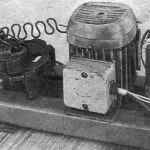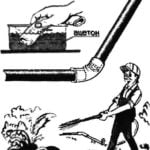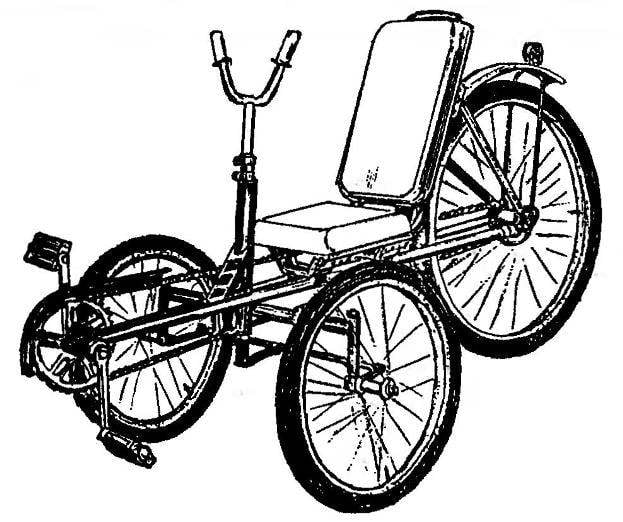Suspension, wheel suspension and steering is pretty straightforward. Rear sprocket, like a Bicycle, is mounted in the lugs of the fork spars. Suspension is front steering wheels, although different from conventional Cycling and is more similar to automobile pivot, but too simple — camber angles and toe is not adjustable.
The pins are freely inserted in the bronze bearings (you can use Teflon) sleeves on the ends of the beam, castellated nuts tightened from above and zaspirtovanny through holes drilled in the threaded ends of the pins. Pins have heads in the shape of a cube with a through lateral openings with a diameter of 12 mm, these holes fixed axis (axle) of the front steering wheels.

Steering:
1 —wheel (steel, pipe 17×1.2); 2 — clamps (steel, band I 1); 3 — bushings-bearings (bronze or PTFE); 4 — steering column; 5 — kerchiefs; 6 — frame rails; 7 — traverse; 8 — steering shaft (steel, pipe 21×1,8); 9 — fry (steel, strip s)
Swivel:
1 — castle nut M10x1 (4x); 2 — washer; 3 — bushings-bearings (bronze or PTFE); 4 — traverse; 5 — pivot bushing; 6 – M5 nuts; 7 — washer; 8 — transverse thrust (Shal, rod d7); 9 — rotary lever (steel, sheet s); 10 — a bolt M5; 11 —knuckles (40Х112МА, tempering to HRC 42…48); 12 — conical nut M8x1 (off the bike); 13 — M4 screws; 14 pins (40KHN2MA, rod d30, tempering to HRC 42.. 48); 15—pin (4 PCs); 16 — lug mount bipod (steel, sheet s2)
Seat frame:
1 —arc (steel, pipe 16×1,5); 2 — seatpost bracket (2 PCs); 3 —clip (STZ, strip s2,5, 2); 4 — eyelet (STZ, sheet 1,5, 2); 5 — brace (steel, pipe 12×1,4, 2); 6-crossmember (steel sheet 1.5, 4x); 7 — bolt M4 spring washer (8 PCs.)
In the bottom face of the head of each pin made a groove and two diagonal of the deaf threaded holes M4. In the grooves with two screws M4 each is fixed ends of the swivel levers. Their other ends pivotally connected with the flattened tie rod ends of steel rod with a diameter of 7 mm. In the middle of the thrust welded eyelet for pivotally attaching the free end of the steering Pitman arm. The other end of the Pitman arm welded to the lower end of the steering shaft, made of thin-walled steel pipe with a diameter of 21 mm, the top of which is made a longitudinal slot.
Shaft in a bronze (or PTFE) sliding bearings are placed in the steering column, top it is inserted in the front steering and all details in place of the slot tightened clamps. Two more clamps on the same shaft above and below the steering column to prevent its longitudinal displacement.
Drive (transmission) is no different from drive a normal road bike, just a little longer chain. Its tension can be adjusted by moving the axle sleeve rear wheel in the slots of the lugs of the fork. When the chain stretches enough to remove one or two links, so that-*the second adjustment is possible again.
Seat veloceleste normal — type chair, only his back is rejected at a significant angle for a more comfortable fit driver. Seat base is an arc of thin-wall steel tube diameter 16 mm with four crossbars of a steel U-shaped profile of 55×10 mm. attached To the crossbars cushion of the seat and backrest. The pillow is simple: on the plywood base glued foam and covered with leatherette top.
The location of the seat on the frame was selected due to the optimal distribution of the load from the weight of the driver on the wheel. Were taken into account and the fact that the height of the driver should provide it with the necessary visibility when driving in traffic. Therefore, the seat is mounted on two stand-Kah-brackets made of the same profile as the cross member, only the size of the shelves he had 15 mm. Brackets fastened to the side members of the frame by a pair of brackets using four M5 bolts each. This mount allows you to move the seat (back or forward) to adjust distance to the pedals on the growth of the driver.
The simplification of the construction of Volokolamsky, in comparison with the prototype, does not entail the eventual elimination of the previous elements, creates a (albeit minor) comfortable drive. If you want, without changing the frame and steering, can be set multi-speed drive, fairing with windshield and roof and the headrest of the seat, thereby making Volokolamskoe back to the recumbent.
D. SHAVEYKO, M and n s K, Belarus
Recommend to read
 COMPRESSOR FROM A REFRIGERATOR
COMPRESSOR FROM A REFRIGERATOR
The advantage of a paint sprayer is well known: it provides quality coverage. Moreover, achieving smooth transitions from one color or tone to another can only be done by spraying. And for... THE INTERSECTION OF PVC
THE INTERSECTION OF PVC
For garden water pipes for watering plants, as a rule, connect the bushing with the thread, which sergevev, makes it difficult to dock. They can be replaced with segments of PVC pipe...


